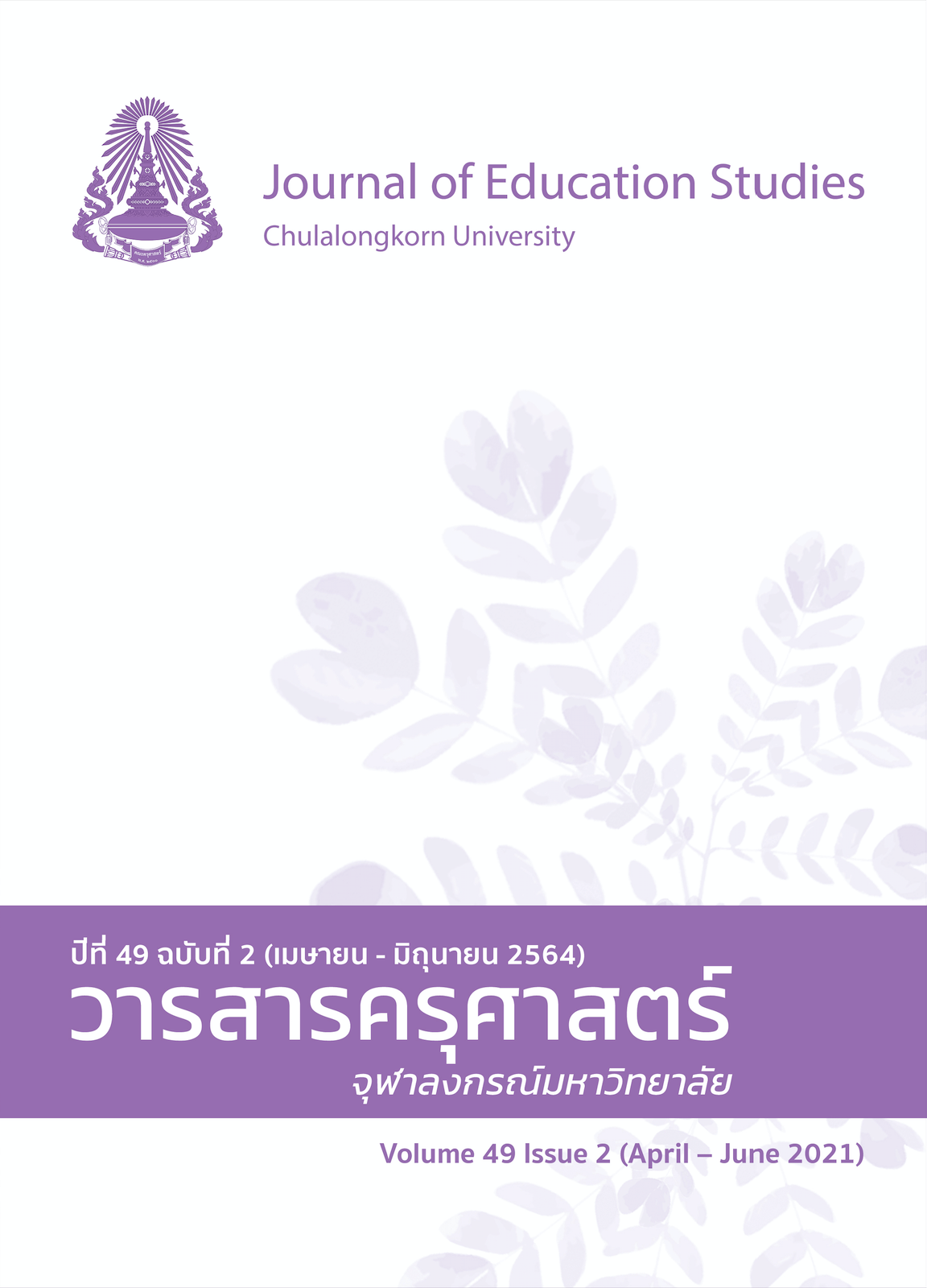Development Learning Activities Based on a Design Thinking Process and Project Based Learning to Enhance Innovators in Grade 10 Students
DOI:
https://doi.org/10.14456/educu.2021.34Keywords:
learning activity, design thinking, project based learning, InnovatorAbstract
The purposes of the research were: 1) to develop and test the efficiency of learning activities based on a design thinking method and project-based learning; 2) to evaluate the innovator abilities of students after using learning activities based on a design thinking method and project-based learning; 3) to survey the student’s satisfaction toward learning activities based on a design thinking method and project based learning. The sample was selected by a purpose sampling technique and comprised of 30 grade ten students. The instruments used for gathering data consisted of 1) lesson plans, 2) an innovator abilities evaluation form, 3) a work pieces evaluation form, and 4) a questionnaire. The results of this research were firstly that the efficiency score of learning activities based on a design thinking method and project-based learning enhanced the innovator levels of students in grade ten. The activity leads students to understand problem through the interview people involved in the problems or the situation. Students collaborate, plan working steps, search and analyze the information for exchanging knowledge and experiences. Students apply the information to create a work piece for solving the problem. Consequently, the efficiency score was higher than the expected criterion (80/80). The second result of the research was that student’s innovator abilities were at a good level and student’s work pieces were at a good level. Thirdly, the student’s satisfaction toward learning activities based on a design thinking method and project based learning to enhance the innovator levels of grade ten students was at a very high level.
References
กระทรวงศึกษาธิการ. (2551). หลักสูตรแกนกลางการศึกษาขั้นพื้นฐาน พุทธศักราช 2551. ชุมนุมสหกรณ์การเกษตรแห่งประเทศไทย.
ชัยยงค์ พรหมวงศ์. (2556). การทดสอบประสิทธิภาพสื่อหรือชุดการสอน. วารสารศิลปากรศึกษาศาสตร์วิจัย มหาวิทยาลัยศิลปากร, 5(1), 7-20
ณัฐกฤตา ไทยวงษ์. (2562). การศึกษาผลการจัดประสบการณ์ตามแนวคิดเชิงออกแบบที่มีผลต่อความคิดสร้างสรรค์ และความสามารถในการแก้ปัญหาของเด็กปฐมวัย. วารสารแสงอีสาน มหาวิทยาลัยมหามกุฏราชวิทยาลัย วิทยาเขตอีสาน, 16(11), 141-153
พันธ์ยุทธ น้อยพินิจ. (กรกฎาคม, 2560). ผลการจัดการเรียนรู้ เรื่อง ภาคตัดกรวย ด้วยกระบวนการคิดเชิงออกแบบที่ส่งเสริมความสามารถในการแก้ปัญหาอย่างสร้างสรรค์ของนักเรียนชั้นมัธยมศึกษาปีที่ 4.[Paper presentation], การประชุมนำเสนอผลงานวิจัยระดับชาติ เครือข่ายบัณฑิตศึกษา มหาวิทยาลัยราชภัฏภาคเหนือ, พิษณุโลก, ประเทศไทย.
ภุชงค์ โรจน์แสงรัตน์ (2563). การพัฒนารูปแบบการสอนโดยใช้แนวคิดการคิดเชิงออกแบบเป็นฐานเพื่อสร้างสรรค์ผลงานที่ปรากฏอัตลักษณ์ไทยสำหรับนิสิตนักศึกษาระดับปริญญาบัณฑิต. วารสารครุศาสตร์ จุฬาลงกรณ์มหาวิทยาลัย, 46(3), 258-273
วาทินี บรรจง (2561). นักออกแบบตัวน้อย: การส่งเสริมความคิดสร้างสรรค์ผ่านประสบการณ์ศิลปะสร้างสรรค์ด้วยกระบวนการคิดเชิงออกแบบ. วารสารครุศาสตร์ จุฬาลงกรณ์มหาวิทยาลัย, 46(2), 330-347
วิชัย วงษ์ใหญ่ และมารุต พัฒผล (2562). การจัดการเรียนรู้ในยุค Disruptive Innovation. http://www.curriculumandlearning.com/upload/Books/Disruptive%20Innovation_1544646601.pdf
วิวัฒน์ มีสุวรรณ์. (2560). ปัจจัยที่ส่งผลต่อคุณลักษณะของครูนวัตกรด้านเทคโนโลยีการศึกษาในสถานศึกษาสำหรับปฏิบัติการสอน เครือข่ายมหาวิทยาลัยนเรศวร. วารสารศึกษาศาสตร์มหาวิทยาลัยนเรศวร, 19(3), 50-61
สุมิตรา บูชา. (2563). การพัฒนากิจกรรมการเรียนรู้รายวิชาชีววิทยาโดยใช้การคิดเชิงออกแบบร่วมกับแนวคิดการเรียนรู้แบบมีส่วนร่วม เพื่อส่งเสริมความคิดสร้างสรรค์ของนักเรียนชั้นมัธยมศึกษาปีที่ 5. วารสารมหาจุฬานาครทรรศน์, 7(12), 210-221
ไปรมา อิศรเสนา ณ อยุธยา และชูจิต ตรีรัตนพันธ์ (2560). การคิดเชิงออกแบบ : เรียนรู้ด้วยการลงมือทำ (Design thinking: Learning by doing). http://resource.tcdc.or.th/ebook/Design.Thingking.Learning.by.Doing.pdf
ภาษาอังกฤษ.
Dyer, J., Gregersen, H., & Chistensen, C. M. (2011). The innovator's DNA: Mastering the five skills of disruptive Innovators. Harvard Business School.
Sterman, C. (2016, October 28). Teaching by design: Design thinking is a problem-solving strategy that help build student’ 21st century skills. http://www.naesp.org/sites/default/TeachingByDesign_CCAC15.pdf
Seidal, V. P., & Fixson, S. K. (2003). Adopting design thinking in novice multidisciplinary teams: The application and limits of design methods and reflexive practices. Journal of Product Innovation Management, 30(SI), 19-33.
The Stanford d.school Bootcamp Bootleg. (2019, February 9). Design thinking bootcamp bootleg. https://dschool.stanford.edu/resources/the-bootcamp-bootleg
Wagner, T. (2018). Creative innovations: The making of young people who will change the world. Scribner.
Downloads
Published
How to Cite
Issue
Section
License

This work is licensed under a Creative Commons Attribution-NonCommercial-NoDerivatives 4.0 International License.




